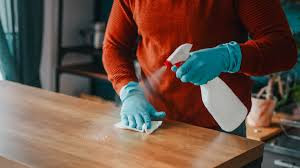How To Disinfect Wood Furniture | With Vinegar | Without Damaging The Finish
The Ultimate Guide to Disinfecting Wood Furniture with Vinegar without Damaging the Finish
When it comes to furniture care & maintenance, wood
holds a special place, displaying warmth, elegance, and timeless appeal
strongly & openly. However, concerning disinfecting wooden furniture,
the process needs precision and care to ensure the surface remains pristine. In
this comprehensive guide, we explore the complexities of disinfecting wood
furniture with vinegar without damaging its finish.
Understanding the Importance of Disinfecting Wood Furniture
Wooden furniture, despite being magnificent, can
harbour bacteria, viruses, and other harmful pathogens, particularly in places with lots of traffic, like living rooms and dining rooms.
If you disinfect your wooden furniture at regular intervals, it not only maintains
the aesthetic appeal but also promotes a healthy environment for inhabitants.
However, traditional cleaning supplies could be dangerous,
which in turn, can damage the wood finish, necessitating a gentle yet effective
solution.
The Power of Vinegar in Disinfecting Wood Furniture
Vinegar has become an adaptable and environmentally safe disinfectant, well recognized for its antimicrobial properties. Its acidic nature makes it efficient against a variety of germs, including bacteria and viruses, while being safe for use on most wooden surfaces. Furthermore, vinegar leaves behind a refreshing scent, completely removing or getting rid of foul odours and imbuing the furniture with a natural freshness.
Steps to Disinfect Wood Furniture with Vinegar
Step 1: Prepare the Solution
Start the process by mixing white vinegar with water in a
1:1 ratio. This balanced solution will ensure optimal disinfection
without causing any harm to the wood finish.
Step 2: Test in an Inconspicuous Area
Before you apply the solution to the entire surface, it is
strongly advised to perform a patch test in an inconspicuous area in order to check
out any adverse reactions. This step helps prevent potential damage as well as
ensures compatibility with the wood finish.
Step 3: Application
With the help of a soft, lint-free cloth, now, you need to dampen
it with the vinegar solution and smoothly wipe the entire surface of the wood
furniture. Pay special attention to areas that are vulnerable or susceptible to
contamination, such as tabletops and armrests.
Step 4: Drying
Allow the furniture to air dry naturally, for which you need
a place with a good amount of ventilation. Avoid using excessive heat or direct
sunlight, because, these may cause the wood to warp or crack.
Step 5: Buffing
Once dry, buff the surface with the help of a clean cloth to
restore its natural shine and lustre. This final step increases the appearance
of the furniture, leaving it looking rejuvenated and inviting.
Additional Tips for Maintaining Wood Furniture
- Avoid
Abrasive Cleaners: Stop yourself from using harsh chemicals or
abrasive cleaners, because these can strip away the protective finish and
leave the wood vulnerable to damage.
- Regular
Dusting: Implement a regular dusting routine with the help of a soft,
microfiber cloth in order to remove surface debris and maintain the
furniture's pristine condition.
- Use
Coasters and Placemats: Place coasters and placemats under glasses,
cups, as well as hot dishes to keep moisture and heat from damaging the
wood surface.
- Annual
Maintenance: Consider applying a protective sealant or wax annually to
protect the wood against wear and tear, prolonging its lifespan.
Conclusion
In conclusion, disinfecting wood furniture with vinegar
offers a safe, effective, as well as environmentally friendly solution to keep
a clean and hygienic living space without compromising the quality of the wood
finish. By following the above-mentioned steps and incorporating proper
maintenance practices, your wooden furniture will continue to look beautiful and last for many years.





Comments
Post a Comment